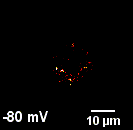Fluorescent Imaging of Cellular Fluxes

Seeing is Believing!
The rapid bursts of ions exiting cells are vital for many physiological processes. The challenge is visualizing these multiple events from cells where the coordinated release of ions is the basis of neuronal, cardiac, and muscle excitability and where perturbation results in human disease. Conventional electrical methods either report on total ion flow from a particular cell (electrophysiology) or an ion concentration at a specific location (ion-sensitive electrodes); however, neither approach provides the spatiotemporal resolution to globally image and measure efflux from the entire landscape of a cell, an intact circuit, tissue, or brain. Therefore, we have been developing a novel cell surface approach to fluorescently visualize ions and metabolites exiting cells.
multiple events from cells where the coordinated release of ions is the basis of neuronal, cardiac, and muscle excitability and where perturbation results in human disease. Conventional electrical methods either report on total ion flow from a particular cell (electrophysiology) or an ion concentration at a specific location (ion-sensitive electrodes); however, neither approach provides the spatiotemporal resolution to globally image and measure efflux from the entire landscape of a cell, an intact circuit, tissue, or brain. Therefore, we have been developing a novel cell surface approach to fluorescently visualize ions and metabolites exiting cells.
Real-time Imaging of Cellular Proton Fluxes
We are using glycocalyx engineering (pioneered by Bertozzi and co-workers) to covalently label the cell surface with small molecule fluorescent pH sensors (cartoon). Using voltage-clamp fluorimetry to simultaneously control and visualize proton transport, we observe robust fluorescent signals that correspond to cellular proton fluxes in both directions—outward and inward. The real-time kinetics of proton accumulation and depletion at the cell surface directly serves as a readout of ion channel and membrane transporter activity. Using our approach, we have observed proton transport through voltage-gated proton channels, chloride/proton antiporters, and omega proton fluxes associated with human disease.
with small molecule fluorescent pH sensors (cartoon). Using voltage-clamp fluorimetry to simultaneously control and visualize proton transport, we observe robust fluorescent signals that correspond to cellular proton fluxes in both directions—outward and inward. The real-time kinetics of proton accumulation and depletion at the cell surface directly serves as a readout of ion channel and membrane transporter activity. Using our approach, we have observed proton transport through voltage-gated proton channels, chloride/proton antiporters, and omega proton fluxes associated with human disease.
